Choosing the Best Air Conditioner for Camping
When it comes to camping, staying cool and comfortable is crucial, especially during the warmer months. Choosing the best air conditioner for camping involves considering various factors that contribute to both performance and convenience. The three most important considerations are size and portability, cooling capacity, and power source. Below, we dive deep into each aspect to help you make an informed decision.
Size and Portability
When selecting an air conditioner for camping, the size and portability of the unit are critical factors. Since you’ll likely be traveling with limited space, a bulky or heavy AC unit may not be practical. Opt for compact, lightweight models that can be easily transported, set up, and stored when not in use.
Why Size Matters
- Compact Design: A small, lightweight unit will ensure that it doesn’t take up too much space in your car or campsite.
- Ease of Handling: A portable air conditioner allows for flexible movement. Whether you’re setting it up in your tent or relocating it under shaded areas, portability matters.
- Quick Setup: Choose a unit that is easy to assemble and doesn’t require complex installation. Many portable units come with simple user guides, ensuring a smooth setup process in minutes.
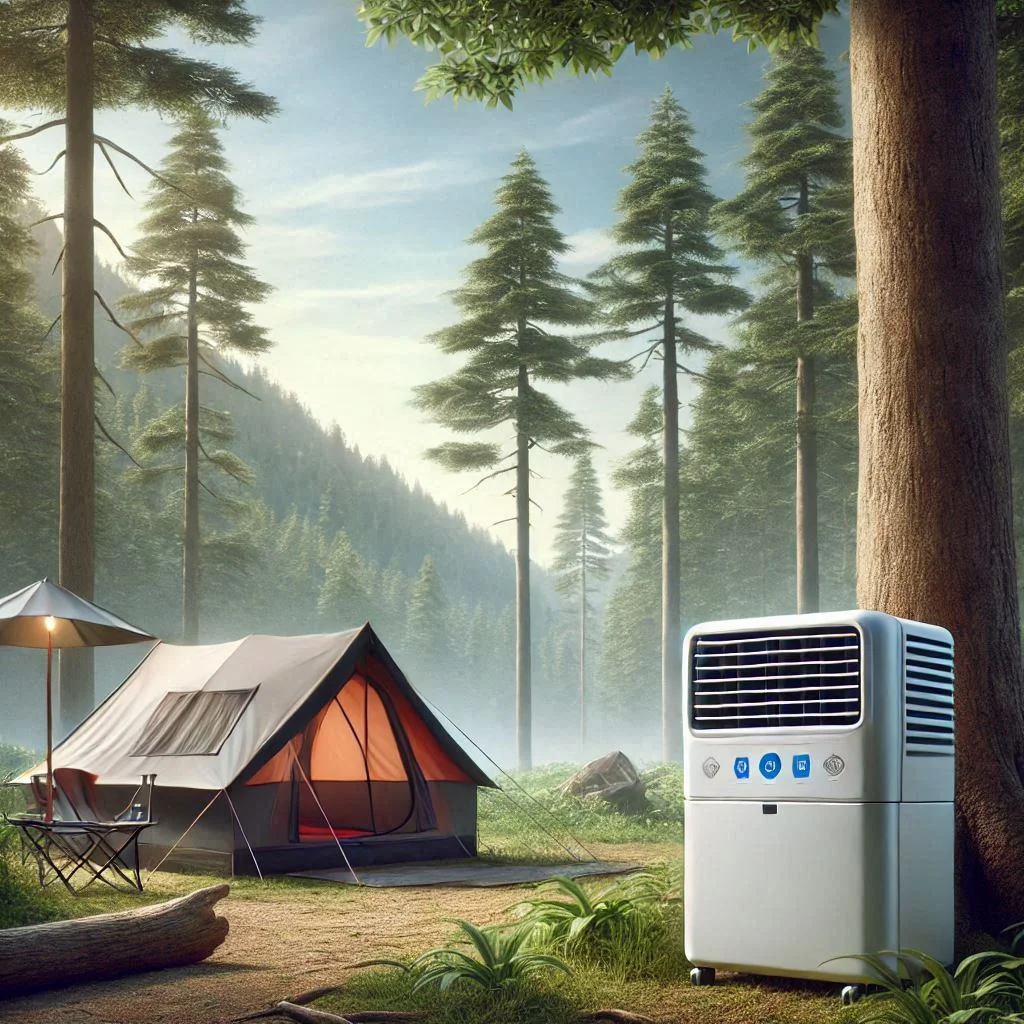
Cooling Capacity
Cooling capacity is one of the most important factors when choosing an air conditioner for camping. It’s essential to select an AC unit that can effectively cool the size of your tent while maintaining energy efficiency.
What to Look For in Cooling Capacity
- BTUs (British Thermal Units): Cooling capacity is typically measured in BTUs. A higher BTU indicates stronger cooling power. For a small tent (around 50–100 square feet), a unit with 5,000–8,000 BTUs will suffice. For larger tents (over 100 square feet), opt for 10,000 BTUs or higher.
- Energy Efficiency: Consider how much energy the unit uses to cool the tent. Efficient units can provide the best comfort without draining too much power, especially important when you’re relying on a portable generator or solar panel.
- Room Size Fit: Always match the cooling capacity to your tent size. An oversized air conditioner may be more powerful but can waste energy, while an undersized one will struggle to cool the space adequately.
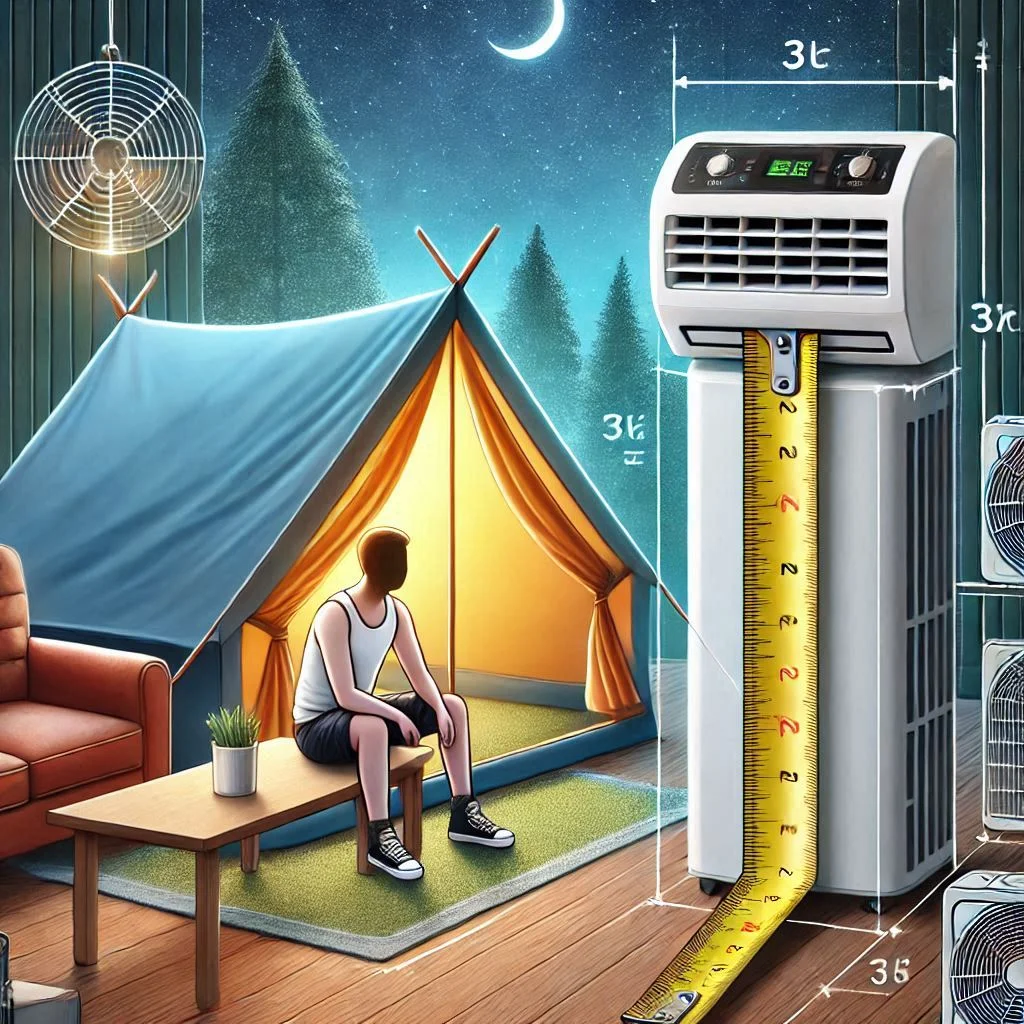
Power Source
Since camping trips often involve remote locations, selecting an air conditioner that can work with various power sources is crucial. Not all campsites have electrical hookups, so ensuring that your AC is compatible with different power options will guarantee you remain cool, even off the grid.
Power Source Options
- Battery-Powered Units: These units are best for short camping trips where you don’t have access to an outlet. However, they may not provide as much cooling power as larger AC models.
- Solar-Powered ACs: For eco-conscious campers, solar-powered ACs are an excellent option. They rely on solar panels to generate power, making them ideal for off-grid camping. Be sure the panels provide enough wattage to run the unit effectively.
- AC Units with Plug-In Compatibility: If you camp near areas with electricity, a traditional plug-in unit with standard 110V power is a great option. Some models come with adapters that work with 12V systems in RVs or cars, making them more versatile.
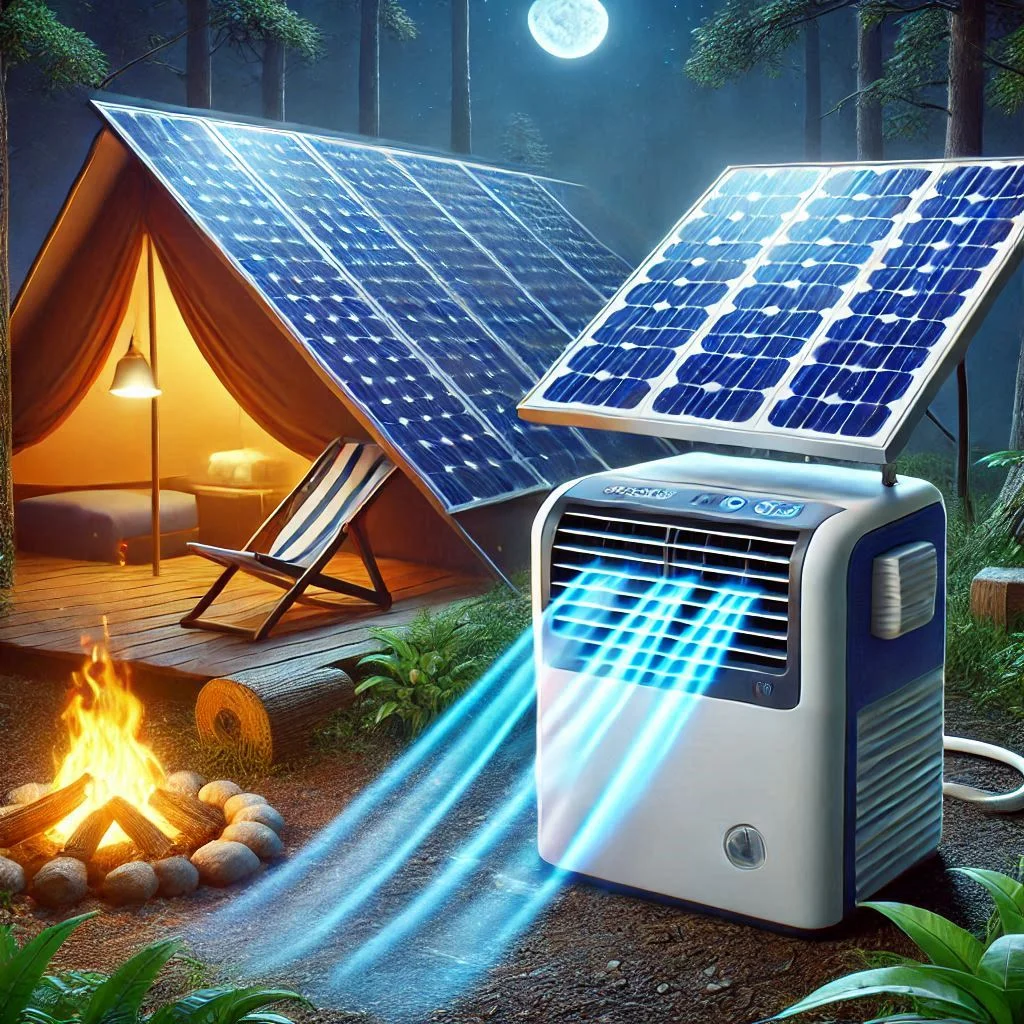
Popular Air Conditioner Models for Camping
Selecting the right air conditioner model for camping is essential to ensure you stay cool and comfortable in your tent. There are various types of air conditioners designed specifically for outdoor use, each offering unique features tailored for campers. In this section, we’ll dive into three popular models: the Zero Breeze Mark, Portable AC Units, and Window AC Units. These models stand out for their reliability, portability, and performance.
Zero Breeze Mark
The Zero Breeze Mark is one of the most popular portable air conditioners for camping, particularly suited for off-grid camping trips. It’s known for its compact design, powerful cooling capacity, and ease of use.
Why Choose the Zero Breeze Mark?
- Compact and Lightweight: Weighing only around 16 pounds, the Zero Breeze Mark is highly portable and easy to carry. Its compact size makes it perfect for smaller tents and tight spaces.
- Impressive Cooling Power: This unit offers cooling capabilities of up to 2,300 BTUs, enough to keep a small tent cool on warm nights. Although not as powerful as larger AC units, it’s highly efficient for camping purposes.
- Battery-Powered: One of the key features of the Zero Breeze Mark is its ability to run on a rechargeable battery, which makes it ideal for remote camping locations where electrical outlets aren’t available. It can run for several hours on a single charge, depending on the setting.
- Versatile Use: Besides being a tent AC, it can also be used in RVs, boats, and cars. Its versatility makes it a go-to option for campers who need an all-in-one cooling solution.
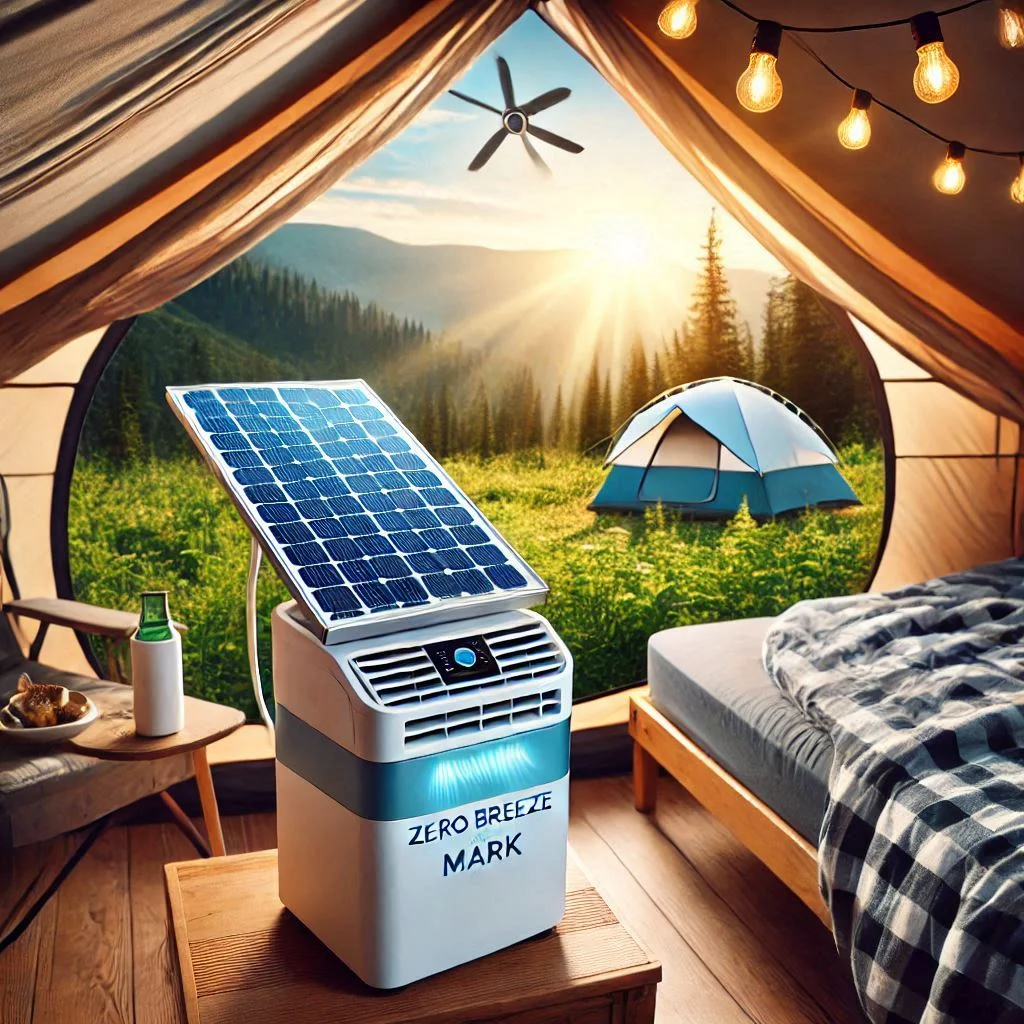
Portable AC Units
Portable air conditioners are a go-to solution for campers who want a reliable, flexible, and easy-to-set-up cooling system. These units come in a variety of sizes and cooling capacities, catering to different tent sizes and camping environments.
Why Choose Portable AC Units for Camping?
- Portability: These ACs are designed to be lightweight and compact, making them ideal for travel. You can easily move them between your car, tent, or RV, providing cooling wherever you go.
- Versatility: Most portable AC units come with multiple power options, such as being powered by an electrical outlet, a battery, or even a generator, offering flexibility for various camping setups.
- Cooling Efficiency: With cooling capacities ranging from 5,000 to 14,000 BTUs, portable AC units can cool a wide range of tent sizes. Smaller units are perfect for 2-3 person tents, while larger models can effectively cool larger tents or RVs.
- User-Friendly: These units are usually equipped with simple controls, including adjustable thermostats, timers, and remote control features, making them easy to operate even in outdoor conditions.

Window AC Units
Window air conditioners, although not traditionally designed for camping, can still be a practical option for campers who are staying at campgrounds with electrical hookups. These units are known for their efficiency, affordability, and powerful cooling capacity.
Why Choose Window AC Units for Camping?
- Powerful Cooling: Window AC units generally have higher BTU ratings, making them suitable for larger tents or campers who are looking for more robust cooling performance. They can offer anywhere from 5,000 to 15,000 BTUs, providing enough cooling for a larger tent or small cabin.
- Energy Efficient: These units are often more energy-efficient compared to some portable units because they don’t require a large battery or generator to run. They are plugged directly into an outlet, which makes them ideal for campsites with electrical hookups.
- Cost-Effective: Window AC units are typically more affordable than portable models, making them an attractive option for budget-conscious campers.
- Permanent Setup: If you’re camping at a fixed location, window ACs are easier to install and don’t require constant repositioning, unlike portable models.
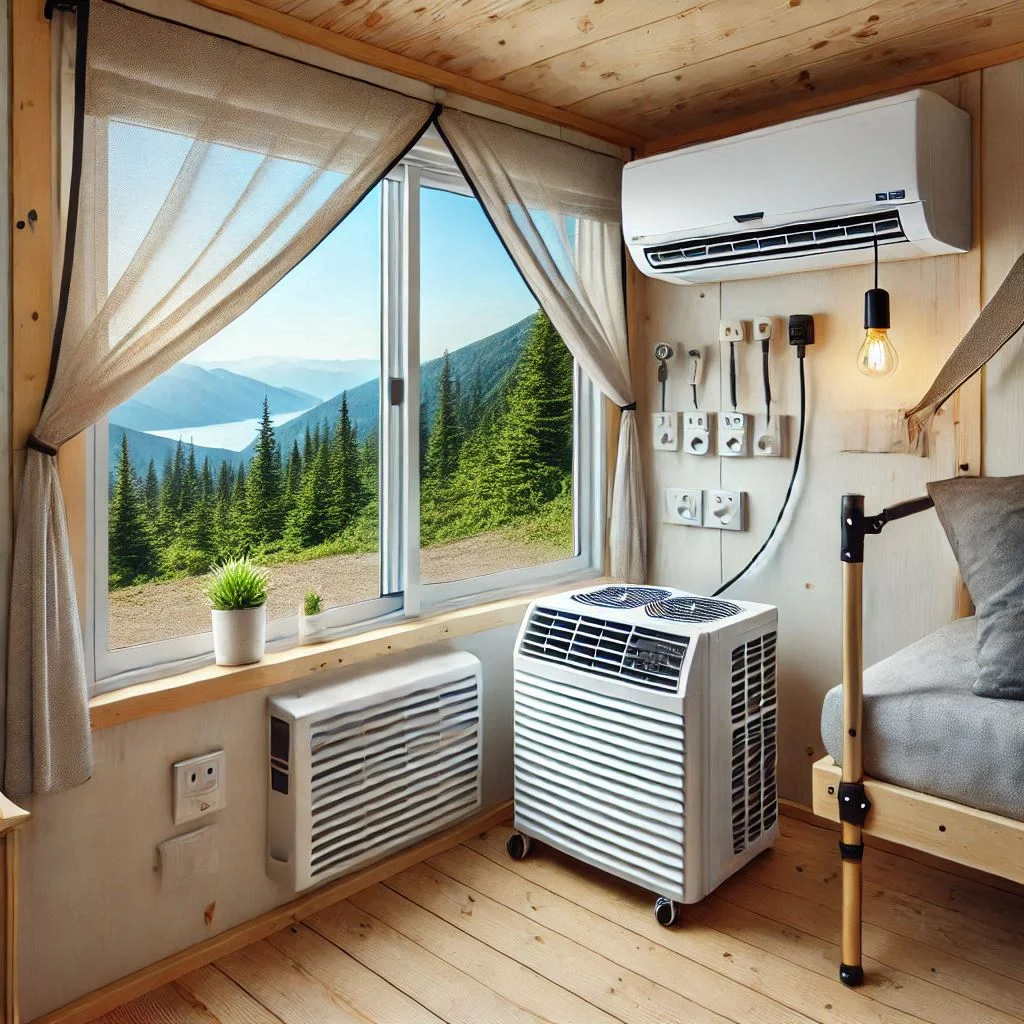
Tent Air Conditioner Installation Tips
Installing an air conditioner in your camping tent is a straightforward process, but there are several essential tips to ensure you get the best performance out of your unit. Proper ventilation, correct positioning, and insulation considerations are key factors that contribute to maximizing the cooling efficiency of your tent air conditioner. Let’s explore each of these important installation tips in detail.
Ventilation and Positioning
Ventilation is one of the most crucial aspects when setting up a tent air conditioner. Proper airflow ensures that the cooling unit works efficiently and prevents the tent from becoming overly humid or stuffy. Additionally, positioning the air conditioner properly inside the tent will allow the unit to circulate cool air effectively.
Why Ventilation Matters
- Airflow Balance: Air conditioners work by expelling hot air while circulating cool air into the space. If the tent is not ventilated correctly, the hot air will have nowhere to go, causing the temperature to rise and making the cooling process less efficient.
- Preventing Humidity: In a tightly sealed tent, moisture can accumulate, leading to high humidity levels. Proper ventilation helps reduce this risk by allowing air to flow freely in and out of the tent. Most air conditioners require a venting hose that expels hot air, so it’s essential to keep that hose clear and directed outside the tent to avoid any build-up.
- Airflow Direction: Position the AC near an entry or exit point of the tent to ensure that cool air can circulate throughout the space. Aim to direct the cold air toward the sleeping area or the center of the tent, where people will be spending the most time.
Tips for Positioning the Air Conditioner
- Near Tent Doors or Windows: Position the air conditioner close to the door or window so you can easily direct the hot air vent outside. This ensures that the unit can expel warm air without interfering with the cooling process.
- Avoid Blocking Vents: Never block the vents of the air conditioner or place objects near the intake. Air conditioners need a clear path to intake and expel air to function effectively.
- Elevate the Unit: If your air conditioner is a portable model, placing it on a raised platform can help prevent debris from blocking the intake vents, particularly in outdoor camping areas where the ground may be uneven or dusty.
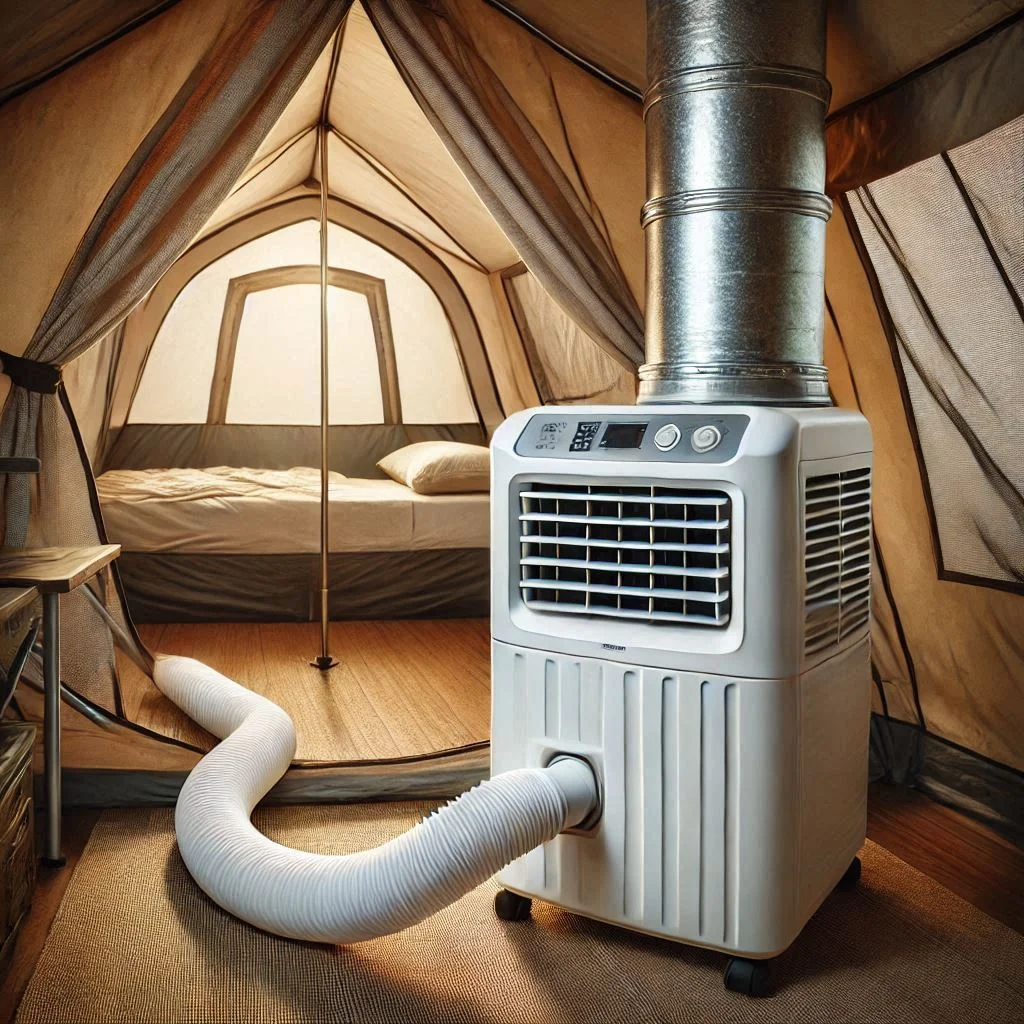
Insulation Considerations
Proper insulation in your tent can make a significant difference in how efficiently your air conditioner cools the space. Without proper insulation, cool air will escape too quickly, and hot air will infiltrate the tent, making the AC work harder and reducing its overall effectiveness.
Why Insulation Matters
- Enhanced Cooling Efficiency: Insulated tents hold cool air inside for longer, helping the air conditioner maintain a lower temperature. This means that the AC won’t need to work as hard to keep the tent cool, which can save energy and prolong battery life if you’re using a battery-powered AC unit.
- Preventing Heat Gain: Insulating the tent helps minimize the amount of heat that enters from the outside. Even during the day, when the sun beats down on the tent, proper insulation will prevent the heat from overwhelming the air conditioner.
- Reducing Humidity and Condensation: Insulated tents can help regulate moisture levels inside. Condensation can form when there’s a significant temperature difference between the cool air inside the tent and the warm air outside. Proper insulation reduces the likelihood of condensation and moisture build-up, ensuring the tent remains comfortable.
Tips for Improving Tent Insulation
- Use Reflective Tarps: Consider using reflective tarps or mylar blankets on the outside of your tent to reflect sunlight and reduce heat absorption. This can significantly lower the internal temperature, making it easier for your air conditioner to maintain a cool environment inside.
- Insulated Tent Liners: If your tent doesn’t come with built-in insulation, consider investing in insulated liners or mats that fit inside the tent. These liners create a barrier between the hot outside air and the cooler inside air, enhancing the efficiency of your air conditioner.
- Close Off Unused Sections: If you’re using a larger tent, consider closing off sections of the tent that are not in use, such as extra rooms or storage areas. This can help concentrate the cool air in the areas where you need it most, making the air conditioner work more efficiently.
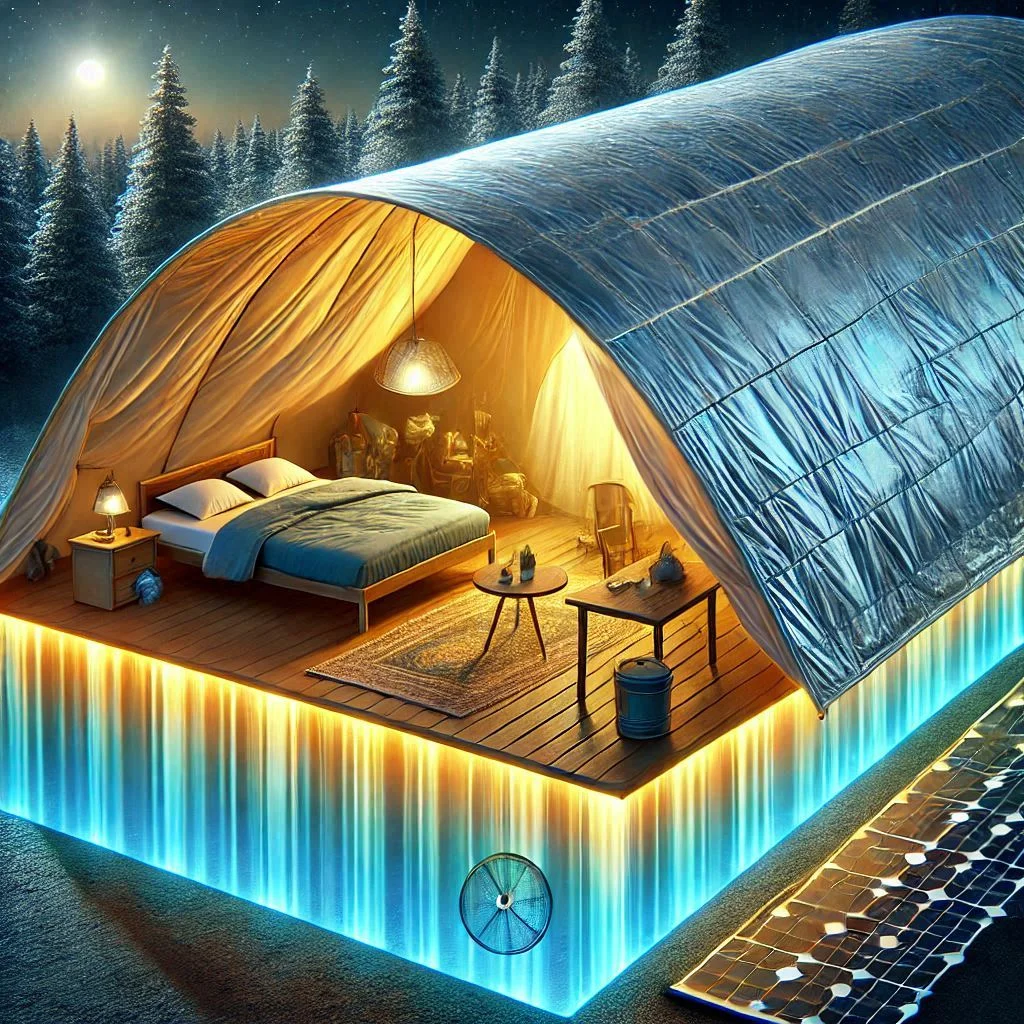
Maintaining Your Tent Air Conditioner
Proper maintenance of your tent air conditioner is essential to ensure it operates efficiently, prolongs its lifespan, and keeps you cool during every camping adventure. Regular cleaning and filter replacement as well as correct storage and transportation practices can go a long way in ensuring that your air conditioner works optimally. Below, we dive into the best practices for maintaining your tent air conditioner.
Cleaning and Filter Replacement
Regular cleaning and filter replacement are crucial steps in maintaining the efficiency and longevity of your tent air conditioner. These tasks prevent dust, dirt, and debris from clogging the unit, which can affect airflow, cooling capacity, and energy efficiency.
Why Cleaning and Filter Replacement Are Important
- Enhanced Airflow: When dust or dirt builds up inside the AC unit, it can block airflow and prevent the system from cooling the tent effectively. Cleaning the unit ensures smooth airflow, which is critical for the air conditioner to work properly.
- Improved Air Quality: A dirty air filter can also trap allergens, dust, and pollutants, which are then circulated inside your tent. Cleaning and replacing the filter regularly helps maintain better air quality and ensures that you’re breathing clean, fresh air while you sleep or relax.
- Preventing Damage: Over time, clogged filters and dirty components can cause the air conditioner to overheat, leading to potential damage to the motor or other parts. Regular cleaning and maintenance help prevent costly repairs and extend the life of your air conditioner.
Cleaning and Filter Maintenance Tips
- Turn Off the AC: Before you begin cleaning, always turn off and unplug the air conditioner. This ensures safety while performing any maintenance tasks.
- Clean the Exterior: Use a soft cloth to wipe down the exterior of the air conditioner, removing any dust or dirt. If the unit is particularly dirty, you can use a mild detergent and water solution, but ensure that the unit is completely dry before turning it back on.
- Clean or Replace the Filters: Filters should be cleaned or replaced regularly, depending on usage. Most filters can be removed easily from the unit and washed with warm water. If the filter is too damaged or clogged, replace it with a new one. For models with reusable filters, wash them every few weeks to maintain airflow.
- Clean the Coils: Dust and dirt can accumulate on the evaporator and condenser coils over time. Use a coil cleaner and a soft brush to clean these parts gently. Keeping the coils clean helps the air conditioner run more efficiently.
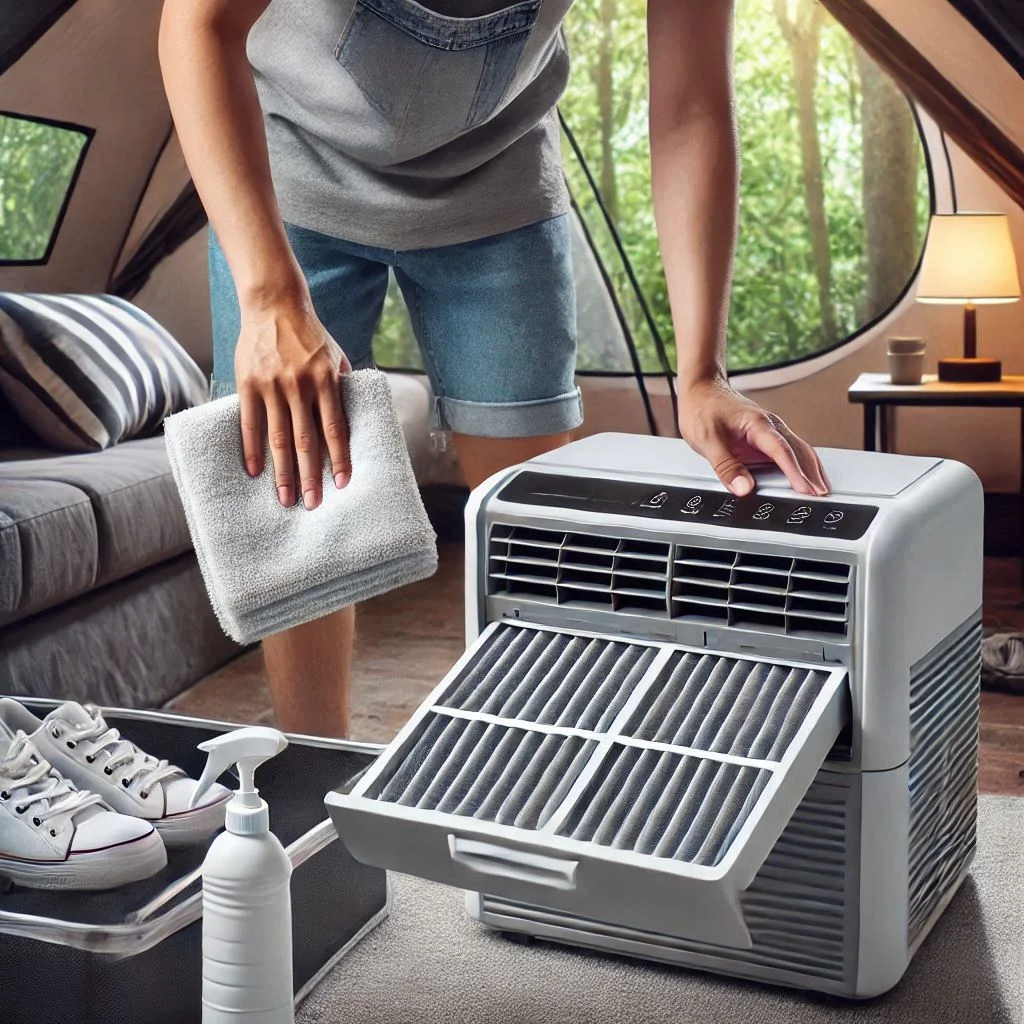
Storage and Transportation
Proper storage and transportation of your tent air conditioner are vital for maintaining its condition and preventing damage when not in use. Whether you’re storing it during the off-season or transporting it between campgrounds, the right handling practices ensure the air conditioner stays in top shape for the next trip.
Why Storage and Transportation Matter
- Protecting Internal Components: Air conditioners contain sensitive internal parts, including the compressor and condenser, that can be damaged if mishandled during storage or transport. Proper storage and careful handling can prevent such damage.
- Preventing Dirt Build-Up: When not in use, dust and debris can accumulate inside the unit, leading to blockages or inefficiencies when you use it again. Storing the unit in a clean, dry place helps prevent this.
- Prolonging the Life of the Unit: Correct storage practices ensure that the air conditioner remains free from moisture and other environmental factors that could cause rust or corrosion, thus extending the life of the unit.
Storage and Transportation Tips
- Keep the Unit in a Dry Place: When not in use, store the air conditioner in a dry, cool place away from direct sunlight, humidity, or extreme temperatures. Moisture can damage internal components, while heat can cause parts to warp or degrade.
- Use a Protective Cover: To protect the air conditioner from dust and debris during storage, use a protective cover. Many portable AC units come with covers designed to keep the unit safe from dirt and moisture.
- Transport Carefully: During transportation, ensure the air conditioner is placed securely in your vehicle or storage area to prevent it from being bumped or dropped. It’s also a good idea to store the unit upright, as placing it on its side could cause fluid to leak and damage the components.
- Discharge Any Remaining Water: If your air conditioner has a water reservoir (for example, a dehumidifier function), be sure to empty it before storage. Leaving water inside the unit can cause mold or mildew to develop, which can damage the unit and create unpleasant odors.
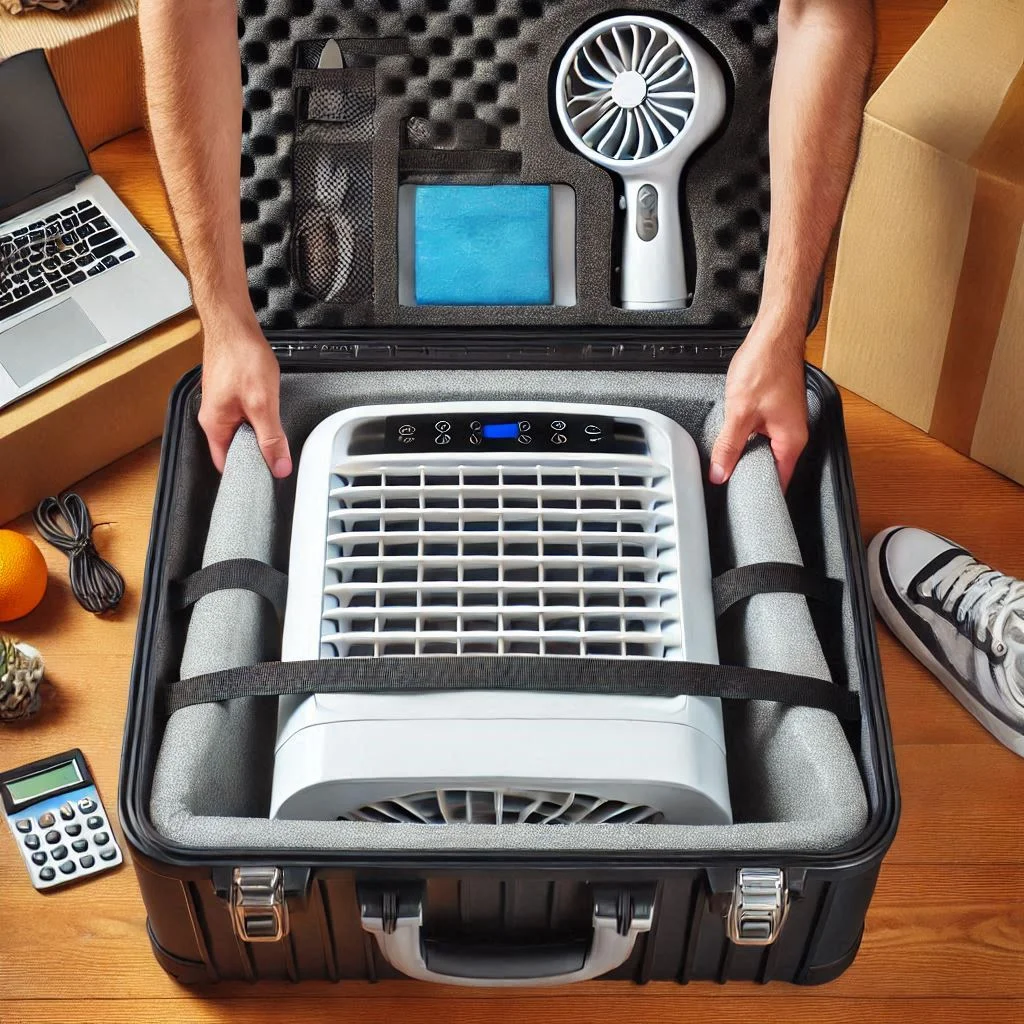
Top 6 Portable Air Conditioners for Camping
When you’re camping, comfort is key, and staying cool during hot weather is essential. Portable air conditioners are a game-changer for outdoor enthusiasts, offering relief from the heat while providing convenience and mobility. Below, we take a closer look at the top 6 portable air conditioners for camping, each with unique features that cater to different needs and preferences. From budget-friendly options to high-performance units, these air conditioners are ideal companions for your next camping trip.
1. The BougeRV Portable Air Conditioner
The BougeRV Portable Air Conditioner is one of the most popular choices for camping due to its compact size and impressive cooling efficiency. Designed for use in RVs, tents, and small spaces, this unit packs a punch without occupying too much room.
Key Features:
- Cooling Capacity: It offers a cooling power of 8000 BTU, which is sufficient to cool small to medium-sized tents or camper vans.
- Energy-Efficient: This unit is known for its energy efficiency, making it a great choice for those who need to run the AC for extended periods without draining the battery.
- Quiet Operation: The BougeRV is known for its relatively quiet operation, ideal for use in peaceful, outdoor environments where noise can disrupt the experience.
- Easy Installation: The installation is user-friendly, and the unit comes with an exhaust hose for easy venting, making it an ideal choice for beginners.
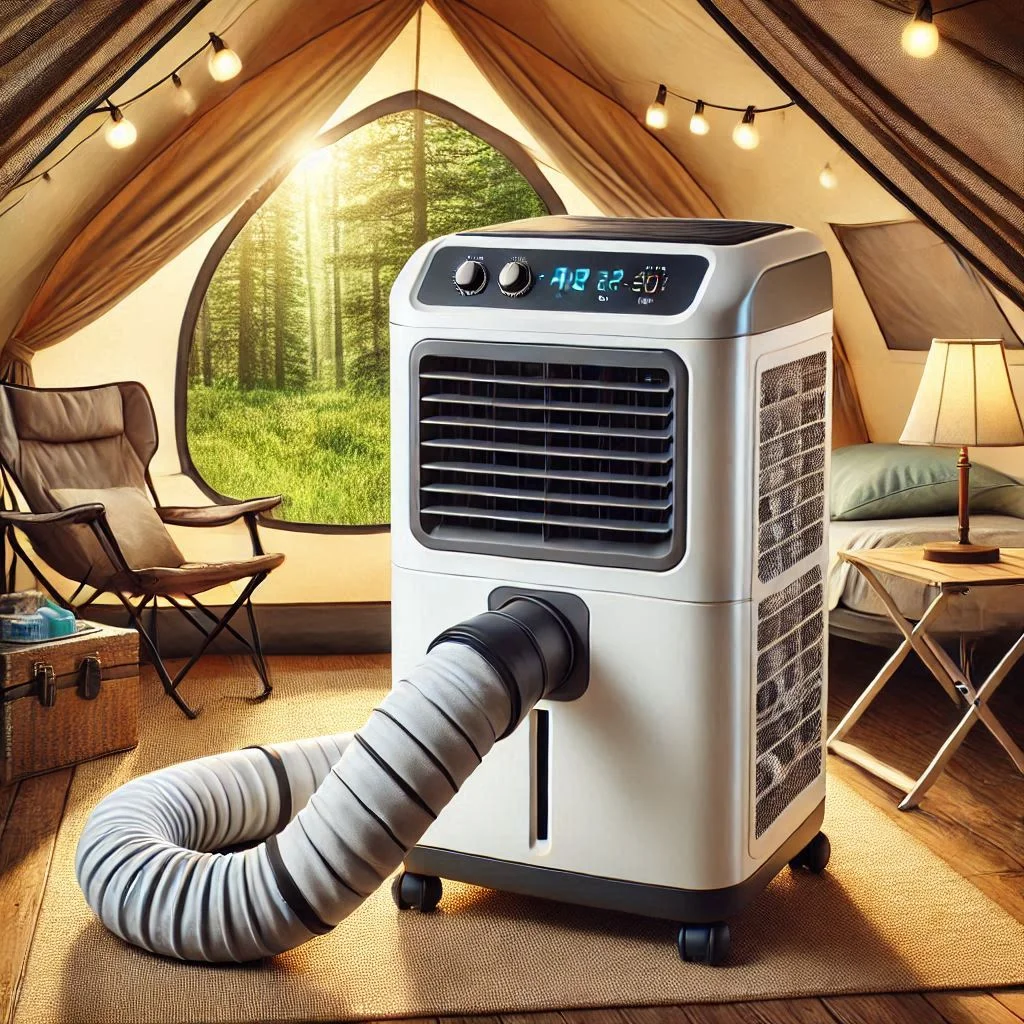
2. The Emerson Quiet Kool
The Emerson Quiet Kool portable air conditioner is another top contender in the camping AC market, offering high efficiency and sleek design. This air conditioner is perfect for campers who want to enjoy a cool tent without compromising on space or comfort.
Key Features:
- Cooling Capacity: With a cooling capacity of 10,000 BTU, this unit is capable of cooling larger tents or small camper spaces, making it an excellent choice for those looking for more robust cooling.
- Quiet Operation: As the name suggests, the Emerson Quiet Kool runs exceptionally quietly, making it perfect for camping where noise can spoil the ambiance.
- Built-in Dehumidifier: This model also functions as a dehumidifier, reducing humidity levels inside your tent, which is especially useful in humid climates.
- Multiple Fan Speeds: It offers multiple fan settings, allowing you to adjust the airflow to your preference.
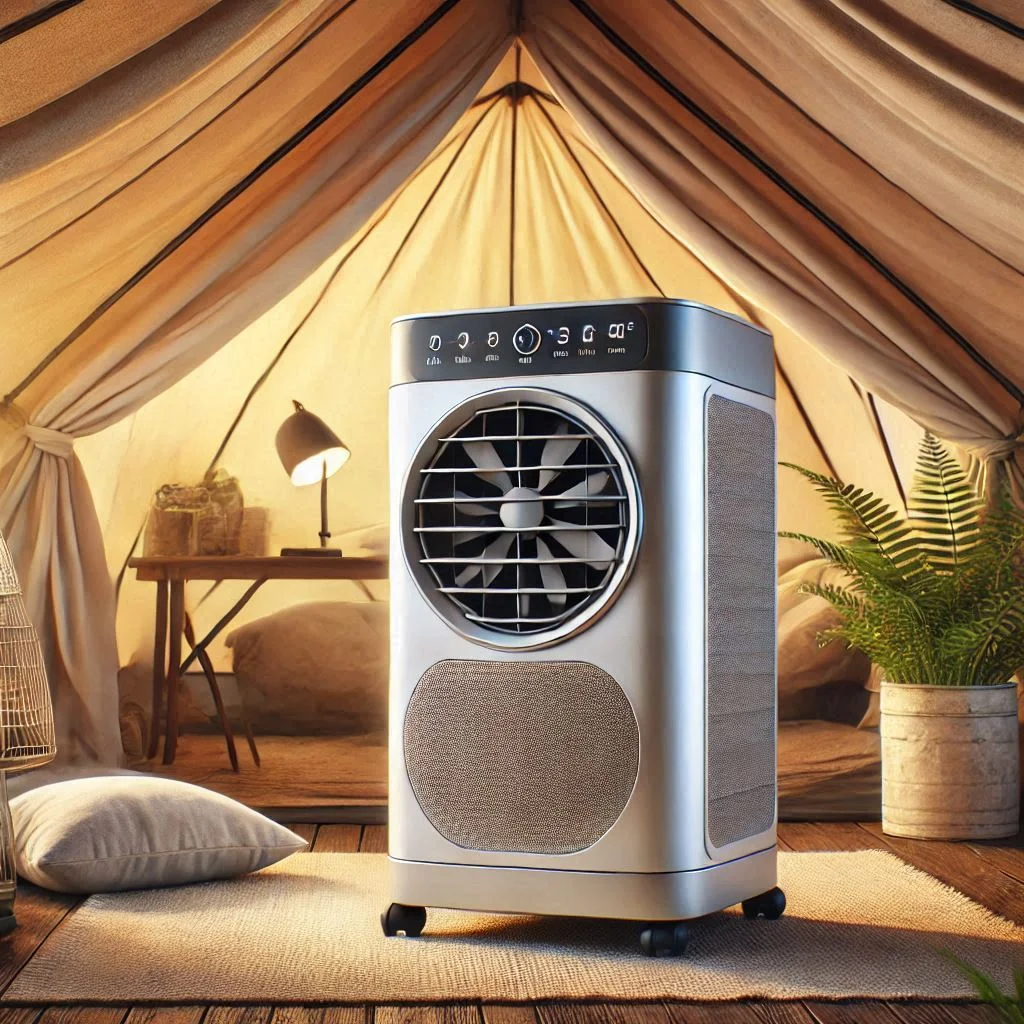
3. The Waykar 1450BTU Portable Air Conditioner
The Waykar 1450BTU Portable Air Conditioner is a lightweight and efficient model, ideal for camping in moderate to hot climates. It’s designed to be compact but powerful, providing relief from the heat without taking up much space in your tent.
Key Features:
- Cooling Capacity: With a cooling power of 1450 BTU, this unit is best suited for cooling small tents or sleeping spaces.
- Versatile Usage: This model is not just an air conditioner; it also functions as a dehumidifier, which is particularly useful for managing moisture in the air during wet or humid camping conditions.
- User-Friendly: It features a simple interface, making it easy to set up and operate, even for those with limited technical knowledge.
- Energy-Efficient: The Waykar is designed to operate on a minimal amount of power, ensuring it won’t drain your energy supplies quickly.

4. The EF ECOFLOW Wave 2 Portable Air Conditioner
The EF ECOFLOW Wave 2 is one of the most innovative portable air conditioners, combining powerful cooling with sustainable energy features. It is perfect for campers who are eco-conscious and want a high-performance unit without compromising their environmental values.
Key Features:
- Cooling Capacity: This AC unit delivers a strong cooling capacity of 4000 BTU, making it suitable for smaller tents or camper vans.
- Solar Charging Capabilities: One of its standout features is its ability to be powered by solar panels, making it a great option for off-grid camping.
- Quiet Operation: The Wave 2 operates at a whisper-quiet level, ensuring a peaceful camping experience.
- Portable Design: It is lightweight and compact, making it easy to carry and set up in different camping locations.

5. The EENOUR PA600 Portable Air Conditioner With Dehumidifier
The EENOUR PA600 is a portable air conditioner and dehumidifier in one, making it a versatile option for camping. This unit can cool your tent while also reducing humidity, making it ideal for wet or damp camping environments.
Key Features:
- Cooling Capacity: The EENOUR PA600 provides 6000 BTU of cooling power, perfect for small tents or RVs.
- Dehumidifier Function: This model excels in humid conditions, offering dehumidification to reduce moisture levels inside the tent.
- Portable and Compact: The PA600 is lightweight and easy to move around, ensuring that it’s perfect for campers who frequently change locations.
- User-Friendly Controls: It comes with a digital control panel for easy adjustments and setting preferences.
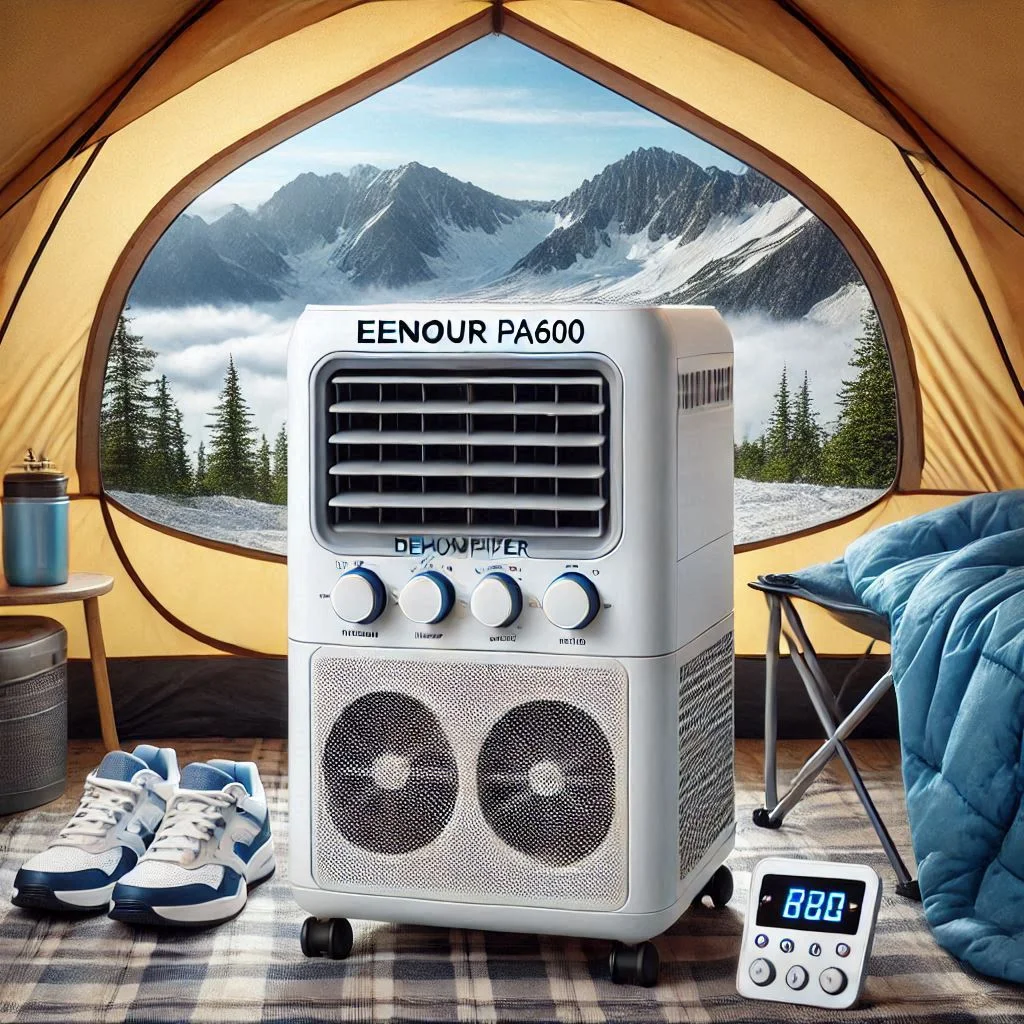
6. The Evapolar evaCHILL Portable Air Conditioners
The Evapolar evaCHILL is a unique air conditioner that uses evaporative cooling to provide relief from the heat. While not as powerful as traditional ACs, it offers a great solution for those looking for something lightweight, portable, and eco-friendly.
Key Features:
- Cooling Method: The evaCHILL uses evaporative cooling, which is an energy-efficient and eco-friendly way to cool your space.
- Compact Size: This model is ultra-portable and easy to carry, making it perfect for minimalist campers.
- Energy Efficient: It consumes very little power, ideal for campers who want to conserve energy while staying cool.
- Eco-Friendly: Unlike traditional air conditioners, the evaCHILL does not require refrigerants, making it a more sustainable option.
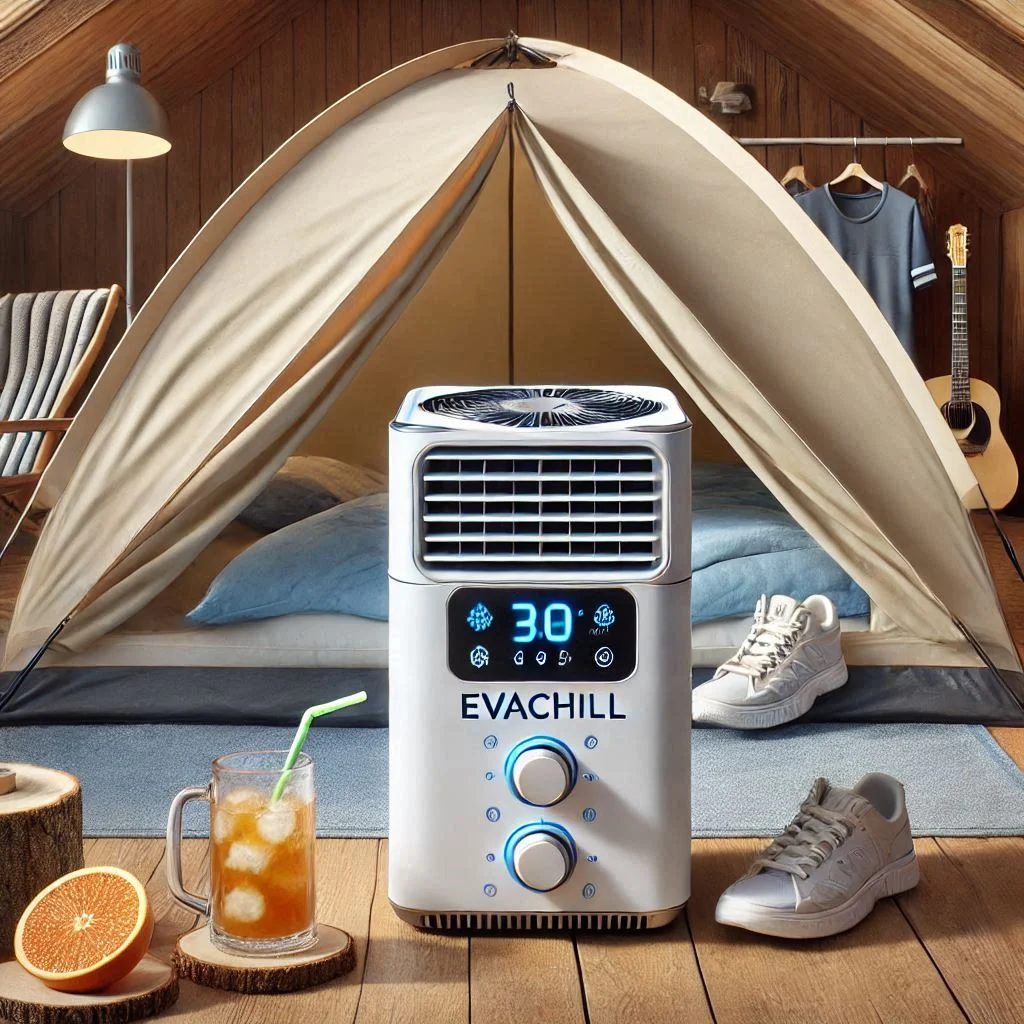
How to Maximize Your Camping AC Experience
Camping doesn’t mean you have to endure uncomfortable heat. With the right air conditioner and the proper setup, you can enjoy a cool and refreshing camping experience, even on the hottest days. To get the most out of your portable camping AC, it’s important to focus on positioning and setup, as well as power considerations to ensure you have a reliable source of energy throughout your trip. Let’s dive into these crucial aspects to maximize your camping AC experience.
Positioning and Setup
Proper positioning and setup of your portable air conditioner is key to ensuring it works efficiently and provides the best possible cooling. Whether you’re using an AC unit in a tent, RV, or camper, the way you position it and set it up can significantly impact its performance.
Why Positioning Matters
- Maximized Airflow: Proper positioning allows your air conditioner to distribute cool air evenly across your tent or camper, ensuring that the temperature stays comfortable throughout. Avoid placing the unit in a corner or enclosed space where air circulation might be restricted.
- Efficient Cooling: If your air conditioner is placed too close to a heat source, such as a stove or direct sunlight, it will have to work harder to cool the space. Ensure the AC unit is placed in a shaded area, away from direct heat or sunlight, to maximize its cooling efficiency.
- Minimized Energy Use: When positioned correctly, your AC will be more efficient in cooling the air, reducing the need for excessive energy consumption. This is especially important during long camping trips where power conservation is crucial.
Setup Tips for Maximum Performance
- Elevate the Unit: If possible, elevate the air conditioner slightly to ensure optimal airflow. This can help it distribute cool air more effectively throughout the tent or camper.
- Ventilation: Ensure the air conditioner has proper ventilation. Most portable AC units require an exhaust hose to vent hot air outside. Make sure the hose is directed outside the tent or camper, and avoid kinks that could block airflow.
- Positioning Relative to Sleeping Area: To maximize comfort, position the AC unit closer to the sleeping area. This will ensure that the cooling effect reaches where you need it most.
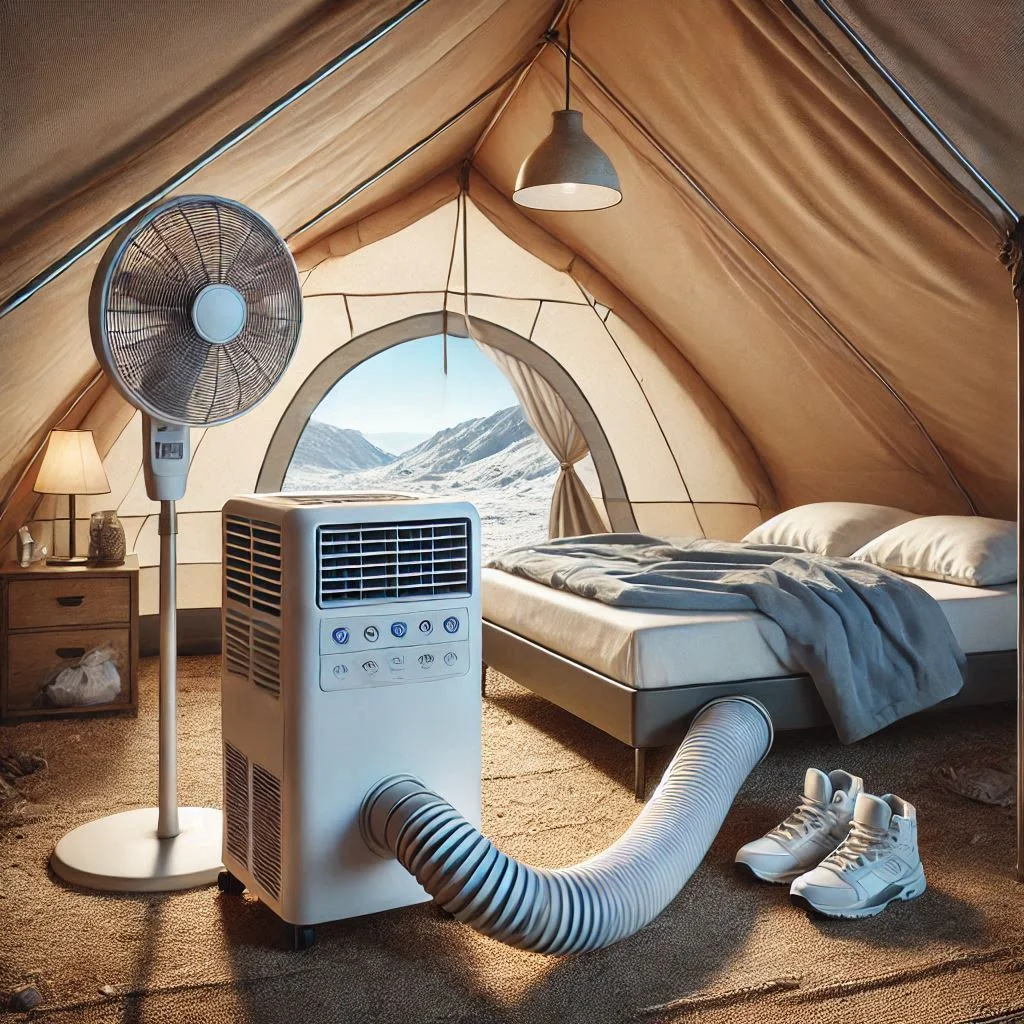
Power Considerations for Long Camping Trips
When you’re camping for an extended period, power considerations are essential to ensure you can run your air conditioner without running out of energy. Depending on the length of your trip, the terrain, and your equipment, having a reliable power source is key to keeping your AC running smoothly.
Why Power Matters
- Battery Life: Portable air conditioners typically require a reliable power source, whether it’s a battery, generator, or solar panel system. If you’re going on a longer camping trip, you’ll need to make sure your power source is sufficient to run the AC unit for the entire duration of your stay.
- Conserving Energy: Many campers use solar panels or portable generators to power their air conditioners. It’s important to use energy-efficient AC units and manage energy consumption by turning the unit off when you don’t need it, or using it on low fan speed during the cooler hours of the day.
- Avoiding Overload: Power systems can become overloaded if too many devices are running simultaneously. Ensure that your power source is capable of handling the load from your air conditioner and other devices, such as lights, phones, and cooking appliances.
Power Options for Camping
- Solar Panels: If you’re camping off the grid, solar panels can provide a sustainable and eco-friendly power source for your air conditioner. Solar generators are also an excellent option for providing power without relying on fuel. Make sure to calculate the wattage your AC unit requires and choose a solar panel system with adequate capacity.
- Portable Generators: For those camping in areas where solar panels might not be effective (such as cloudy regions or shaded environments), portable generators are a reliable option. Make sure to select a generator with enough power to run your AC unit for extended periods. A good rule of thumb is to have a generator that can provide at least 1.5 times the wattage of your air conditioner.
- Batteries: Battery-powered air conditioners are ideal for shorter trips or for campers who don’t want to carry a generator. However, battery-powered AC units may have limited cooling capacity and runtime, so consider this when planning your camping trip.
Energy-Saving Tips
- Use the AC at Night: Since temperatures drop at night, you may not need the air conditioner running all the time. Use the AC primarily at night for sleeping, when it’s cooler outside, and switch to a fan or other methods of cooling during the day.
- Opt for Smaller AC Units: If you’re camping in a small space, opt for a compact, low-power AC unit that still provides adequate cooling but consumes less energy. Smaller units are easier to manage and can be run on smaller power sources.
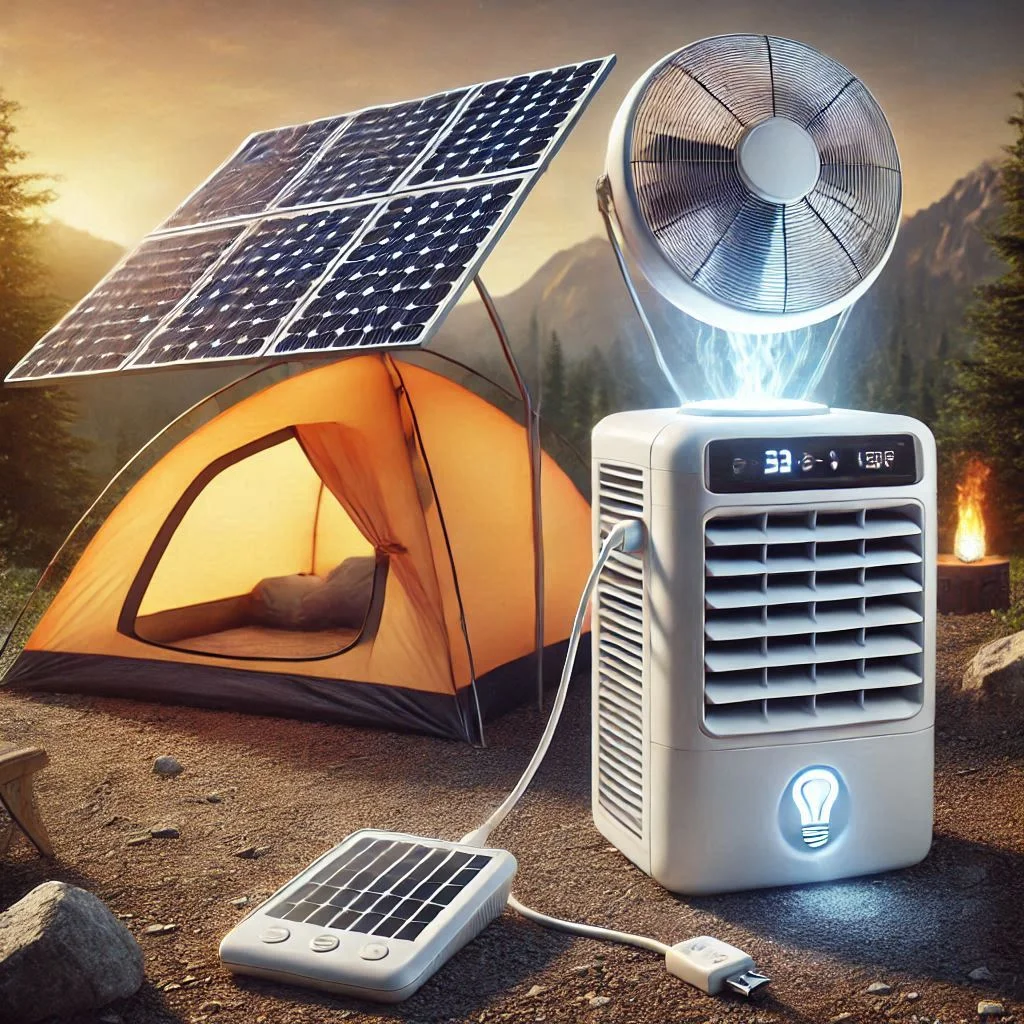
FAQ: Everything You Need to Know About Camping Air Conditioners
When preparing for a camping trip, one of the biggest considerations is staying comfortable, especially during the hotter months. A camping air conditioner can make a world of difference, but understanding the different types, setups, and maintenance is key. Here are the most frequently asked questions about camping air conditioners, answered in detail to help you make an informed decision and maximize your camping comfort.
1. What is the Best Type of Air Conditioner for Camping?
When it comes to choosing the best air conditioner for camping, there are a few key options:
- Portable Air Conditioners: These are highly popular for camping due to their compact size and ease of use. They are perfect for cooling small spaces like tents and RVs. They work by drawing in warm air, cooling it, and then circulating the cooled air back into the space.
- Window Air Conditioners: While not as portable as other options, these units are ideal for campers who have access to a space where they can install the unit temporarily. Window air conditioners are more powerful and often more efficient than portable units.
- Tent-Specific Air Conditioners: These are smaller, portable AC units designed specifically for tent use. Many feature battery-powered or solar-powered options to keep you off the grid. They’re great for lightweight camping and easy setup.
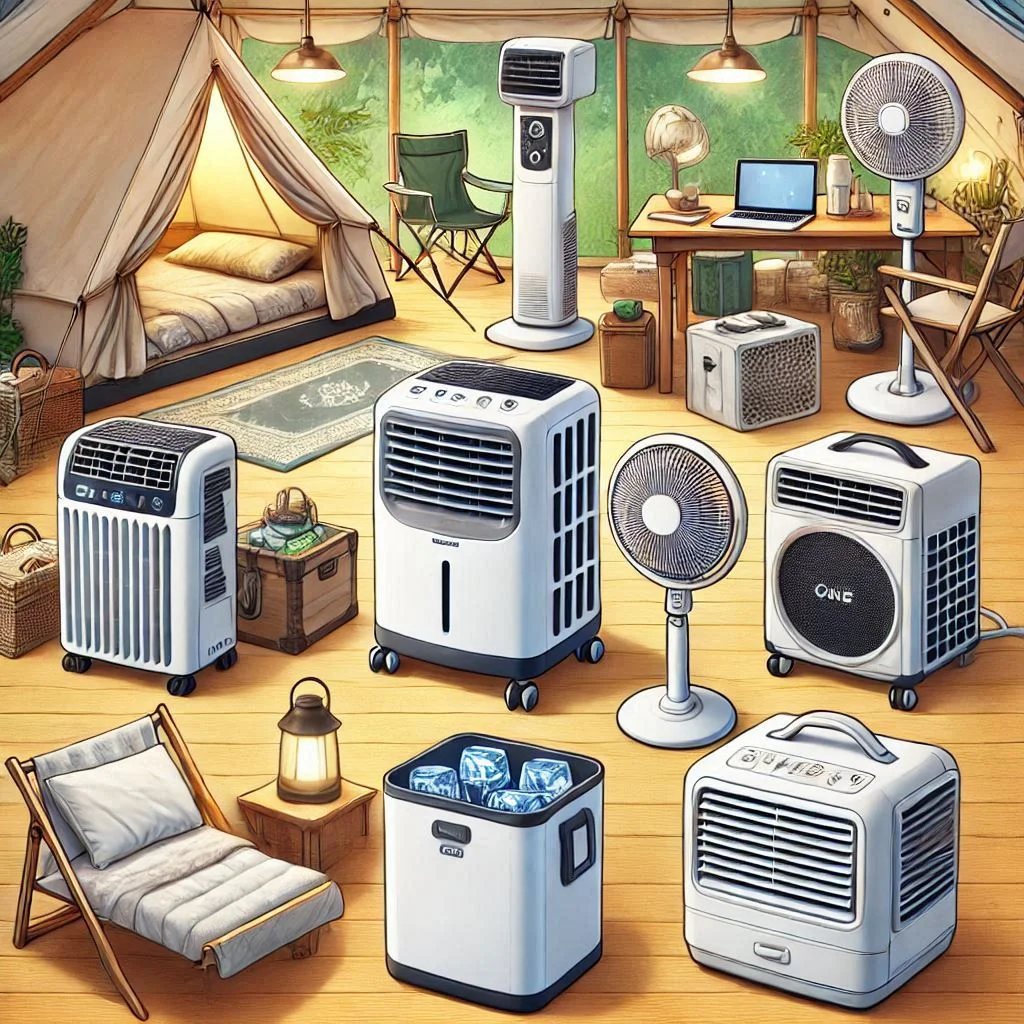
2. How Do I Properly Install a Portable Air Conditioner in a Tent?
Installing a portable air conditioner in a tent involves a few important steps to ensure it works efficiently:
- Choose the Right Spot: Place the AC unit near the sleeping area or where you’ll be spending most of your time. Ensure the area is flat and stable to prevent the unit from tipping over.
- Ensure Proper Ventilation: The air conditioner needs to vent the hot air outside of the tent. Use the exhaust hose that comes with the unit to direct the hot air outside. Make sure the hose is not kinked or obstructed to ensure optimal airflow.
- Seal Off Gaps: Tents often have gaps around the door and windows. Use weatherstripping or a tent air conditioner adapter to seal these gaps to prevent cool air from escaping and warm air from entering.

3. How Long Can I Run a Camping Air Conditioner?
The duration you can run a camping air conditioner depends on several factors:
- Power Source: If you’re using a generator, solar power, or battery, the runtime will vary. Solar-powered air conditioners can run as long as there is enough sunlight to recharge the panels. Battery-powered units may run for a few hours before needing a recharge.
- AC Unit Size: Larger, more powerful units consume more energy, so they may have shorter runtimes compared to smaller, more energy-efficient models.
- Energy Management: If you’re concerned about running the AC for long periods, consider using it only during the hottest parts of the day or primarily at night. You can also use fans to help circulate the cool air during cooler parts of the day.
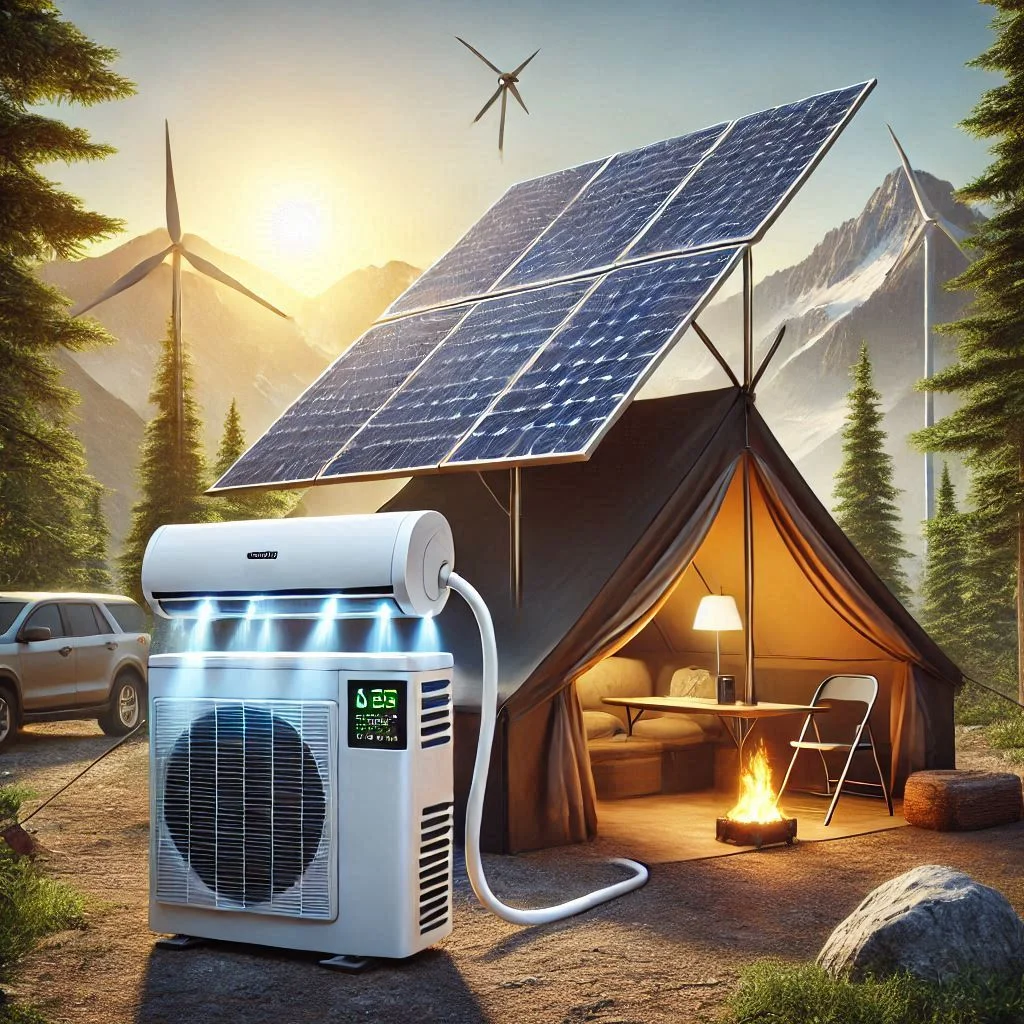
4. How Do I Maintain My Camping Air Conditioner?
Proper maintenance of your air conditioner is crucial to ensure it operates effectively during your camping trip. Here are some key maintenance tips:
- Cleaning Filters: Always clean the filters before and after each trip. Dirty filters can reduce the unit’s efficiency and lead to poor airflow. Use a vacuum or gently wash the filter with soap and water.
- Check for Blockages: Ensure that the exhaust hose and vents are not blocked or clogged with debris, as this can hinder airflow and cooling performance.
- Storage: When storing your camping air conditioner for the off-season, ensure it is properly cleaned and stored in a dry place. Remove any water from the unit to avoid mold or mildew growth.
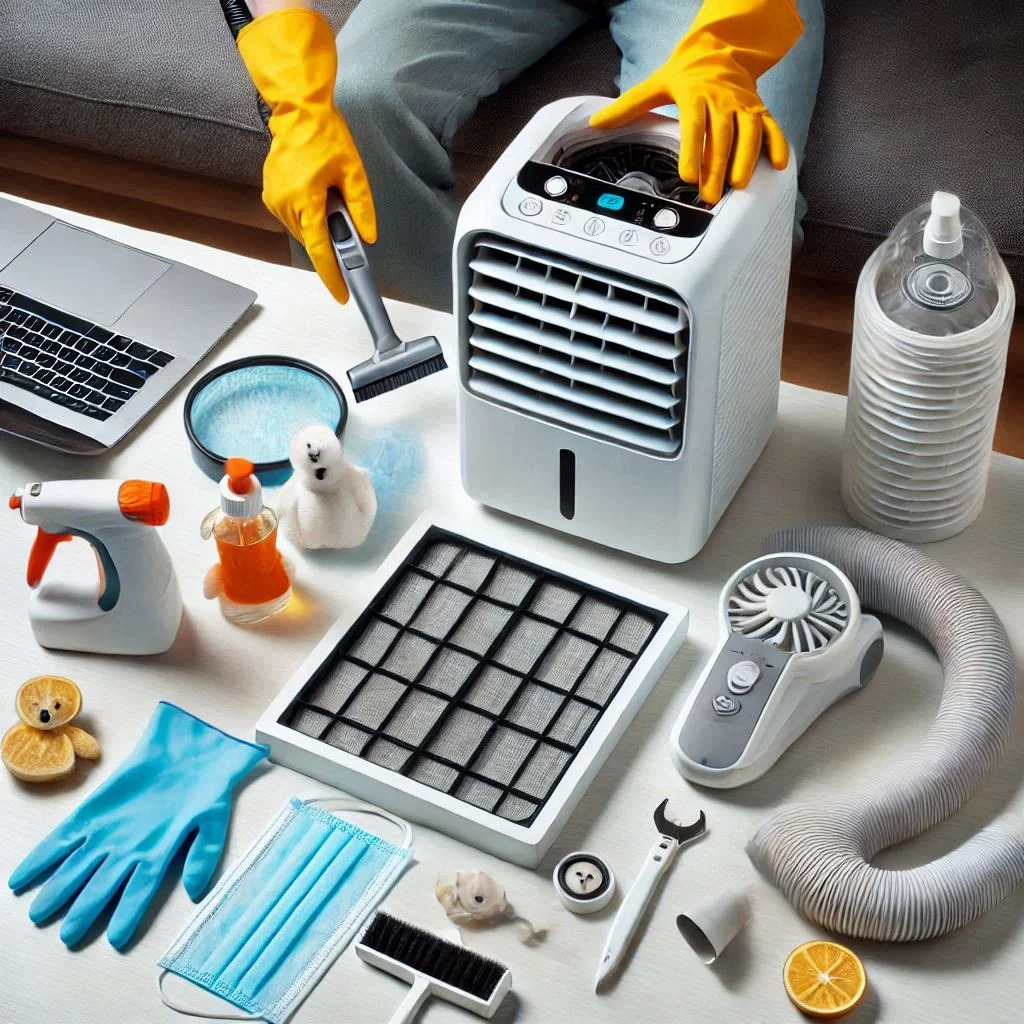
5. Can I Use a Camping Air Conditioner in an RV?
Yes, portable air conditioners can work effectively in RVs. Many RV owners use portable AC units to cool their living spaces. However, there are a few important things to consider:
- Space Constraints: Ensure that your RV has enough space for the AC unit and ventilation hose. Many RVs are already equipped with air conditioning, but portable units can be useful when additional cooling is needed.
- Power Supply: Most RVs have built-in generators or access to shore power, making them ideal for running a portable air conditioner. Ensure your power system can handle the AC unit’s energy requirements.
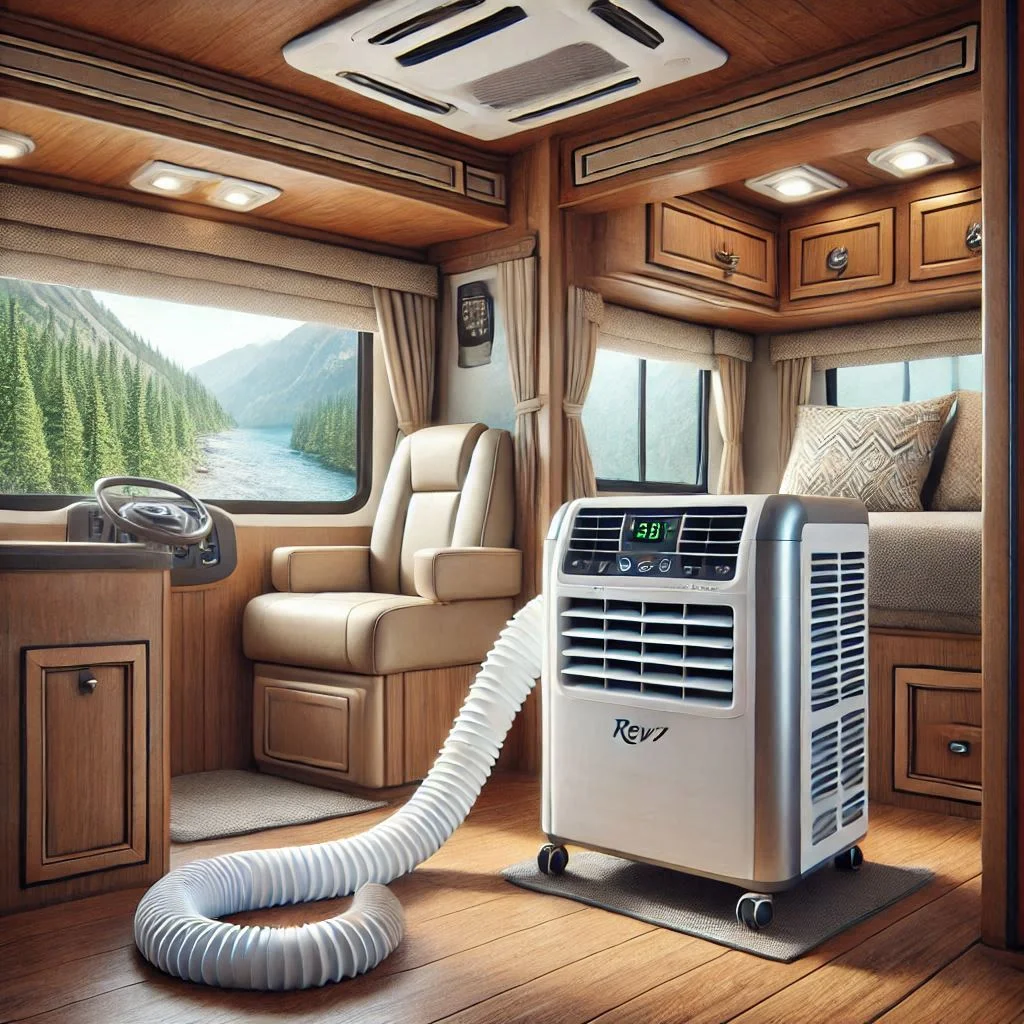
6. Are Solar-Powered Air Conditioners Suitable for Camping?
Yes, solar-powered air conditioners are a great option for environmentally-conscious campers. These units use solar panels to power the AC, making them an excellent choice for off-grid camping. However, solar-powered ACs have some limitations:
- Limited Power: Solar-powered units are often smaller and have less cooling capacity compared to traditional AC units. They are ideal for keeping a small tent or camper cool but may not be sufficient for larger spaces.
- Dependence on Sunlight: Solar-powered units rely on consistent sunlight to operate efficiently. On cloudy or rainy days, you may need to adjust your usage or rely on other power sources.
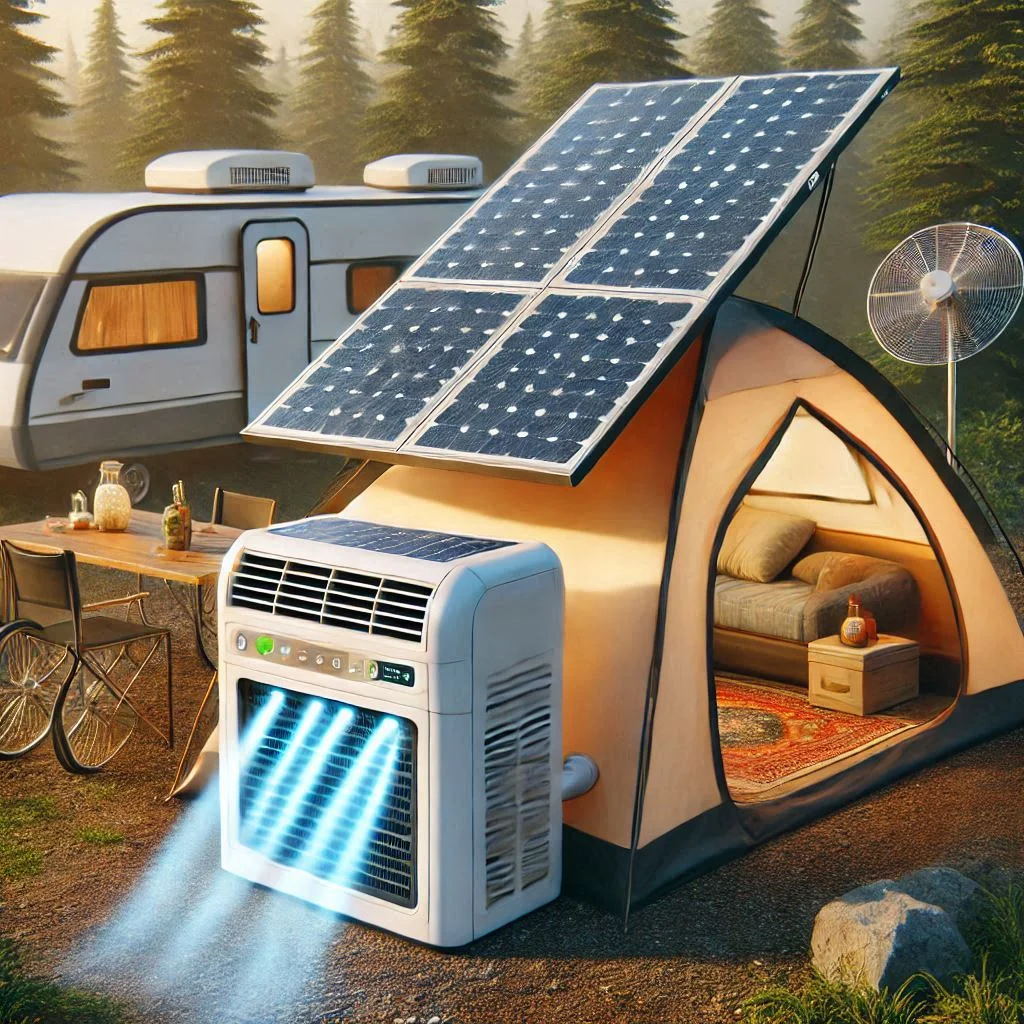
Conclusion
In conclusion, staying cool during your camping trip is no longer a challenge with the right air conditioner and setup. From choosing the best type of air conditioner for your camping needs to ensuring proper installation and maintenance, the key to a comfortable experience lies in understanding your equipment and environment. By considering factors like positioning, power sources, and energy efficiency, you can maximize your air conditioner’s performance, ensuring a relaxing and enjoyable time in the great outdoors. Whether you opt for a portable unit, a window AC, or a solar-powered solution, these tips will help you stay cool, no matter where your adventures take you. With the right tools and knowledge, your next camping trip can be the ultimate escape—cool, comfortable, and worry-free.

